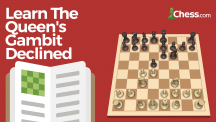3 Deadly TRAPS to Win in 6 Moves [Works up to 1800 ELO] - Remote Chess Academy
Por um escritor misterioso
Descrição
We hope you had a wonderful Father’s Day, a day that celebrates the special bond between fathers and their chess-playing children. Let me take a moment to remind you that time is running out to take advantage of our incredible Father’s Day special offers. You can get all our courses and packages with a huge 60% discount (with up to a massive 80% discount on some courses). Remember, this is only till Thursday, 22 June. Hurry up and get your favourite courses now! << Browse our courses and packages >> In today’s video lesson, we’re going to explore 3 lethal traps in the Scotch Gambit that can help you target Black’s vulnerable square f7 and secure a victory within just 6 moves. These tactics are particularly effective at lower to intermediate levels of play, up to 1800 ELO. By implementing these strategies, you’ll be able to achieve quick checkmates and celebrate those juicy victories on the chessboard. Below, you can find the traps shown in the video: The Scotch Game chess opening arises after the moves: 1.e4 e5 2.Nf3 Nc6 3.d4. Trap #1: Risky, but rewarding 4.Ng5 One of the riskier yet high-reward traps initiated in the Scotch game arises after playing 4.Ng5. The aim is to put pressure on Black’s position by targeting the f7-square. The move 4.Ng5 sets the stage for a quick checkmate. Although objectively not the best move, it can catch unsuspecting opponents off guard. The most common response by Black is 4…h6, trying to push the knight back, but it’s already a losing mistake. Instead of retreating with the knight, White can win by 5.Nxf7, forking the Black queen and rook. After 5…Kxf7 6.Bc4+ Ke8, there is a forcing checkmate in 6 moves! Trap #2: Exploiting vulnerabilities with 4.Bc4 In this variation of the Scotch Gambit, you respond with 4.Bc4. Now, Black’s two common moves, 4…Bc5 or 4…Nf6, open up opportunities to exploit their position. If they play 4…Bc5, you can respond with 5.c3, threatening to capture the pawn on d4 and attack the bishop simultaneously. Black’s likely response, 5…dxc3, turns out to be a critical mistake. The ensuing 6.Bxf7+ move leads to a winning position. With tactical precision, you can regain material while maintaining a significant advantage. Watch the full video lesson here. Trap #3: Targeting f7 with two attackers The final trap arises when Black plays 4…Nf6 in response to the Scotch Gambit. This move is frequently played and requires careful preparation to secure a favorable outcome. By playing 5.Ng5, you can maintain pressure on the f7-square. When Black plays 5…d5, you can trade pawns with 6.exd5 Nxd5 and get a winning position in just 6 moves! You can play the simple move 7.0-0 which sets the stage for a devastating attack. The exposed Black king becomes a prime target, and with accurate moves, you can dismantle their defenses and emerge victorious. Want to see the complete variation? Watch the full video lesson here.
![3 Deadly TRAPS to Win in 6 Moves [Works up to 1800 ELO] - Remote Chess Academy](https://preview.redd.it/why-is-this-getting-extremely-popular-encountered-this-3-v0-av4ssjif1csa1.jpeg?width=1080&format=pjpg&auto=webp&s=a9640a40640abed36ab69c6eb49bceb4a51046f7)
Why is this getting extremely popular, encountered this 3 times a row, it went how would you expect it to (2nd pic) : r/chessbeginners
![3 Deadly TRAPS to Win in 6 Moves [Works up to 1800 ELO] - Remote Chess Academy](http://chess-teacher.com/wp-content/uploads/2023/06/Father-Banner.webp)
3 Deadly TRAPS to Win in 6 Moves [Works up to 1800 ELO] - Remote Chess Academy
![3 Deadly TRAPS to Win in 6 Moves [Works up to 1800 ELO] - Remote Chess Academy](https://media.very.ie/i/littlewoodsireland/VMPIN_SQ2_0000000099_N_A_SLf/sky-viper-vector-performance-stunt-jet.jpg?$180x240_retinamobilex2$)
Robotics, Toys
![3 Deadly TRAPS to Win in 6 Moves [Works up to 1800 ELO] - Remote Chess Academy](https://gwern.net/doc/ai/nn/transformer/gpt/dall-e/3/2023-12-04-gwern-dalle3-amanonthetelephonesdumbshowmakesyouwonderwhyheisalive.jpg)
Miscellaneous ·
![3 Deadly TRAPS to Win in 6 Moves [Works up to 1800 ELO] - Remote Chess Academy](https://slatestarcodex.com/blog_images/threadversarial.gif)
OT101: Threadversarial Collaboropen
![3 Deadly TRAPS to Win in 6 Moves [Works up to 1800 ELO] - Remote Chess Academy](https://i.ytimg.com/vi/fXvdMlhC4LA/maxresdefault.jpg)
Win in 5 Moves With This Deadly TRAP for White After 1.e4
![3 Deadly TRAPS to Win in 6 Moves [Works up to 1800 ELO] - Remote Chess Academy](https://unesdoc.unesco.org/in/rest/Thumb/image?id=p%3A%3Ausmarcdef_0000021941&author=Matthes%2C+Hendrik+G.&title=The+Climatological+city+of+Peter+van+Gogh&year=1977&TypeOfDocument=UnescoPhysicalDocument&mat=ART&ct=true&size=512&isPhysical=1)
The Climatological city of Peter van Gogh
![3 Deadly TRAPS to Win in 6 Moves [Works up to 1800 ELO] - Remote Chess Academy](https://i.redd.it/why-is-this-getting-extremely-popular-encountered-this-3-v0-fuxpw3rjz8sa1.jpg?width=1080&format=pjpg&auto=webp&s=13f5e8c40bf73c0555746d8cbd5f8712e81edc4c)
Why is this getting extremely popular, encountered this 3 times a row, it went how would you expect it to (2nd pic) : r/chessbeginners
![3 Deadly TRAPS to Win in 6 Moves [Works up to 1800 ELO] - Remote Chess Academy](https://chess-teacher.com/wp-content/uploads/2021/09/3-Biggest-Mistakes-Chess-Players-Make.png)
Blog - Page 8 of 56 - Remote Chess Academy
![3 Deadly TRAPS to Win in 6 Moves [Works up to 1800 ELO] - Remote Chess Academy](http://www.numericana.com/answer/legall.gif)
Chess - Numericana
Crafty/src/main.c at master · MichaelB7/Crafty · GitHub
Although I know how to play chess, I have never been able to win against good players. Where am I lacking? - Quora
de
por adulto (o preço varia de acordo com o tamanho do grupo)







